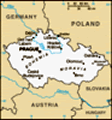Advertisement
Published: October 12th 2017
Leaving Cesky Krumlov this morning, we headed for Prague, with a brief stopover in the town of Karlstejn, where the famous Karlstejn Castle is located. We had tried to find a way to fit Karlstejn Castle into the schedule of our last holiday in Europe, however, we were headed in a different direction from Prague, driving to Vienna. This holiday, we made Karlstejn a priority. On arriving in Karlstejn and parking in the designated car park, we started our walk up the two kilometre 15% incline to get to the castle.
Karlstejn is a large Gothic Castle founded 1348 AD by Charles IV, Holy Roman Emperor-elect and King of Bohemia. The castle served as a place for safekeeping the Imperial Regalia as well as the Bohemian/Czech crown jewels, holy relics, and other royal treasures. Located about 30 klms southwest of Prague above the village, it is one of the most famous and most frequently visited castles in the Czech Republic.
Founded in 1348, the construction works were directed by Vitus of Bítov, but there are no records of the builder himself. It is likely that there was not a progressive and cunning architect, but a
brilliant civil engineer who dextrously and with a necessary mathematical accuracy solved technically demanding problems that issued from the emperor's ideas and requests. Holy Roman Emperor Charles IV personally supervised the construction works and interior decoration. In 1422, during the siege of the castle, Hussite attackers used possibly the first instance of biological warfare, when Prince Sigismund Korybut used catapults to throw dead (but not plague-infected) bodies and 2,000 carriage-loads of dung over the walls,apparently managing to spread infection among the defenders. Despite this, the castle defenders outlasted the siege.
Our trusty guide for the castle, Eva, led us through the various rooms of the castle, and was very skilled at conveying the history of the castle. When we arrived in the relics room, Eva pointed out the skull of a slain dragon. That’s not a slain dragon, that’s a crocodile skull I said. The peasants of the day would not have known that it wasn’t a slain dragon skull, and would have been in awe of the “Dragon Slayer”. For pointing out this fact, Eva handed me the keys to the castle to open up the next room.
After finishing the tour, we
walked around the castle walls taking some photos, before descending the mountain and walking back to our car, via a Segafredo coffee shop.
From Karlstejn we drove into the centre of Prague to our accommodation, for which the online photos did not do justice. It was an upmarket hotel, with a marble staircase leading up to a 24 hour Reception, within walking distance of the Old Town of Prague. Only downside was no car space at our accommodation, however, the hotel provided us with free car parking at a sister hotel twenty minutes walk away, which was great.
After checking in, we googled GF Restaurants, and located an Italian GF Restaurant in the Old Town, where we were shown to a table downstairs in an old stone cavern, which was the original street level in Prague. The food was great, and after leaving the restaurant, we headed straight for the famous Charles Bridge over the Vlata River, stopping only to buy a gelati. On our last visit to Prague the bridge was closed due to high flood waters in the river, and due to the age of the bridge structure, it was decided to
close the bridge at that time for safety reasons.
It was great to finally walk over the Charles Bridge, at night, taking photos of the imposing Prague Castle and St Vitus Church above the river. Prague Castle is the largest castle complex in Europe, and was used by the Nazis during WWII as their Czechoslovakian centre of operations. Reinhard Heydrich was the Governor of the Protectorate of Bohemia and Moravia after they were “annexed” by Hitler. Heydrich was the author of the Final Solution and second only in rank to Heinrich Himmler in the SS, and he installed himself in Prague Castle. He was known as the Butcher of Prague.
After crossing over the Charles Bridge, taking photos, we walked back through the Old Town to the Town Square, checking out the famous Astronomical Clock attached to the Town Hall and the churches surrounding the square. There were people everywhere enjoying the Old Town, along with street buskers, fire eaters, piano players etc. Just a great vibe on the streets. Apart from renovations to major buildings, Prague hadn’t changed much in four years.
Tomorrow we are joining
a World War II Tour of Prague, which will follow the history of the brutal oppression of the Czech nation both prior to and during WWII, highlighting the brave efforts of the Czech Partisans who fought back against the Nazis.
Advertisement
Tot: 0.258s; Tpl: 0.011s; cc: 9; qc: 50; dbt: 0.0832s; 1; m:domysql w:travelblog (10.17.0.13); sld: 1;
; mem: 1.2mb












